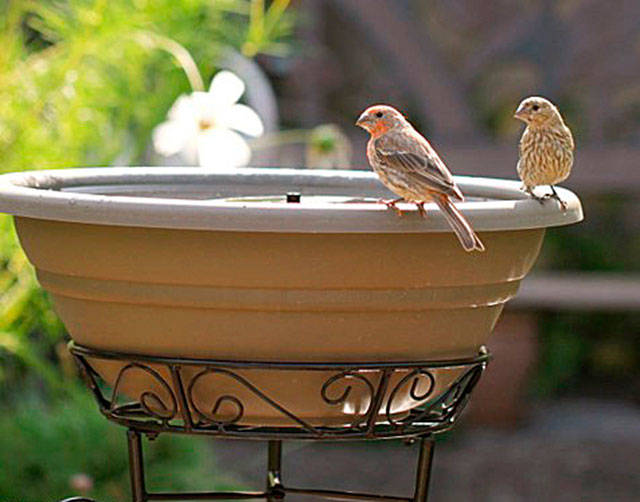What could be more delightful than sitting in your garden and enjoying the hard-earned fruits of your gardening labor? Perhaps sharing your garden with the local wildlife, especially birds.
Birds work in tandem with predatory insects such as parasitic wasps, native bees, predatory flies, and spiders to keep the voracious insect herbivores that damage your plants in check. Many beneficial insects offer the bonus of cross pollinating your vegetables, fruit trees and shrubs. Birds do not discriminate and will eat both herbivorous and predatory insects, keeping populations at manageable levels.
In fact, Northwest songbirds such as bluebirds, chickadees, grosbeaks, sparrows, swallows, nuthatches, woodpeckers and hummingbirds, to name a few, depend on insects for the protein boost they and their chicks need during breeding season. Consequently, the birds’ demanding appetites help remove woodborers, grasshoppers, grubs, aphids and whiteflies among other pests from your garden during the peak growing season.
There are three basic components necessary to make a garden attractive to feathered gardening companions (and their predatory insect partners): food, water and shelter.
For food, planting nutrient-rich native plants is a sure way to attract insects and birds. Once established, native plants are hardy, easy to care for, and offer a varied food source. Mix them with those lovely ornamentals that are bred largely for their good looks not necessarily their nectar, seeds or fruit. The showy ornamentals may attract insects and birds, but it’s the nutritious native plants that will keep them coming back for more.
A palette of flowering herbaceous perennials, evergreen and deciduous shrubs and trees that will bloom from spring to early summer might include such hardy natives as bigleaf lupine, camas, checkermallow, Oregon grape, vine maple, mock orange, and red flowering currant. Goldenrod, aster, evergreen huckleberry, Nootka rose, Pacific ninebark, and Douglas spirea will bloom and fruit from mid-summer through fall. This list of plants is just a sampling of the possibilities.
Check the Xerces Society website at or the Washington Native Plant Society at for suggestions on more native plants that will grow well in your home garden.
A bird bath is a suitable water source for both insects and birds. Toss in a few rocks for the insects and hummingbirds to keep them above water. A bird bath can be as simple as a shallow saucer placed on the ground or atop an overturned pot. Change the water once or twice a week to keep it clean of bird droppings and algae.
Finally, plant trees and shrubs that will provide year-round shelter from the sun, wind, and predators. If you have a dead tree in your yard, consider keeping it. As needed, have an arborist trim it of potentially hazardous falling branches and reduce it to a height that will keep it from toppling over and causing damage. The woodpeckers will love you for it. The holes they drill in pursuit of woodboring beetles may serve as nesting cavities for them and other small birds and animals. Be tolerant of a little mess in the yard and create slash piles of broken twigs and branches for the birds to shelter, play and nest in.
With little effort, your reward will be a garden filled with life. Surely there is nothing as delightful as getting dive-bombed by an amorous rufous hummingbird on a warm summer day.
Sara Faranelli is a Clallam County Master Gardener.


